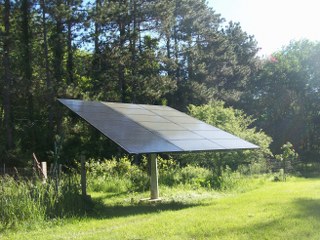Guest post by Roy Van Cleef, New England Clean Energy Technical Sales
I generally tell customers that regular rain showers in New England keep solar panels clear of dust and pollen. But after a recent, particularly heavy accumulation of pollen on every exposed outdoor surface, I was curious as to the specific effect of the pollen on my daily solar production. I have micro-inverters, so I can monitor the production of each individual panel in my 18-panel array.

Early in the morning recently, I went out and hosed down six of my panels, which had a dramatic visual effect (see photo at left). But what was the actual effect on production? At the end of that sunny day, I looked at how the clean panels had performed relative to the unwashed panels. The clean panels produced on average 0.7% more than the pollen-coated panels.
To put this in perspective, a 5-kW array may produce about 30 kilowatt-hours (kWh) on a sunny day. A 0.7% increase in production would be an additional 0.21 kWh per sunny day (.007 x 30 hours). That may have been enough energy to offset the electricity required to run my well pump for a few minutes while I ran the water to clean my panels. But then again, maybe not.
How many days a year do we actually have pollen on the panels? Being generous, we’ll go with 10% of the year, or 36 days. If all those days happen to be sunny, the total production loss over the year is 7.56 kWh (36 “pollen days” x 0.21 kWh per day), out of the 6,000 or so kWh the system will produce.
Let nature take its course.
(After the next rain, in case you’re wondering, the pollen panels were as clean as the ones I washed off.)
If you liked this article, you might also enjoy:
- STC vs. PTC: Why Solar Panel Testing Matters
- Tree Math 2: Solar vs. Trees, What’s the Carbon Trade-off?
- Solar Makes Sense, Even in Snowy Climates


 Download our 7 FAQs
Download our 7 FAQs


